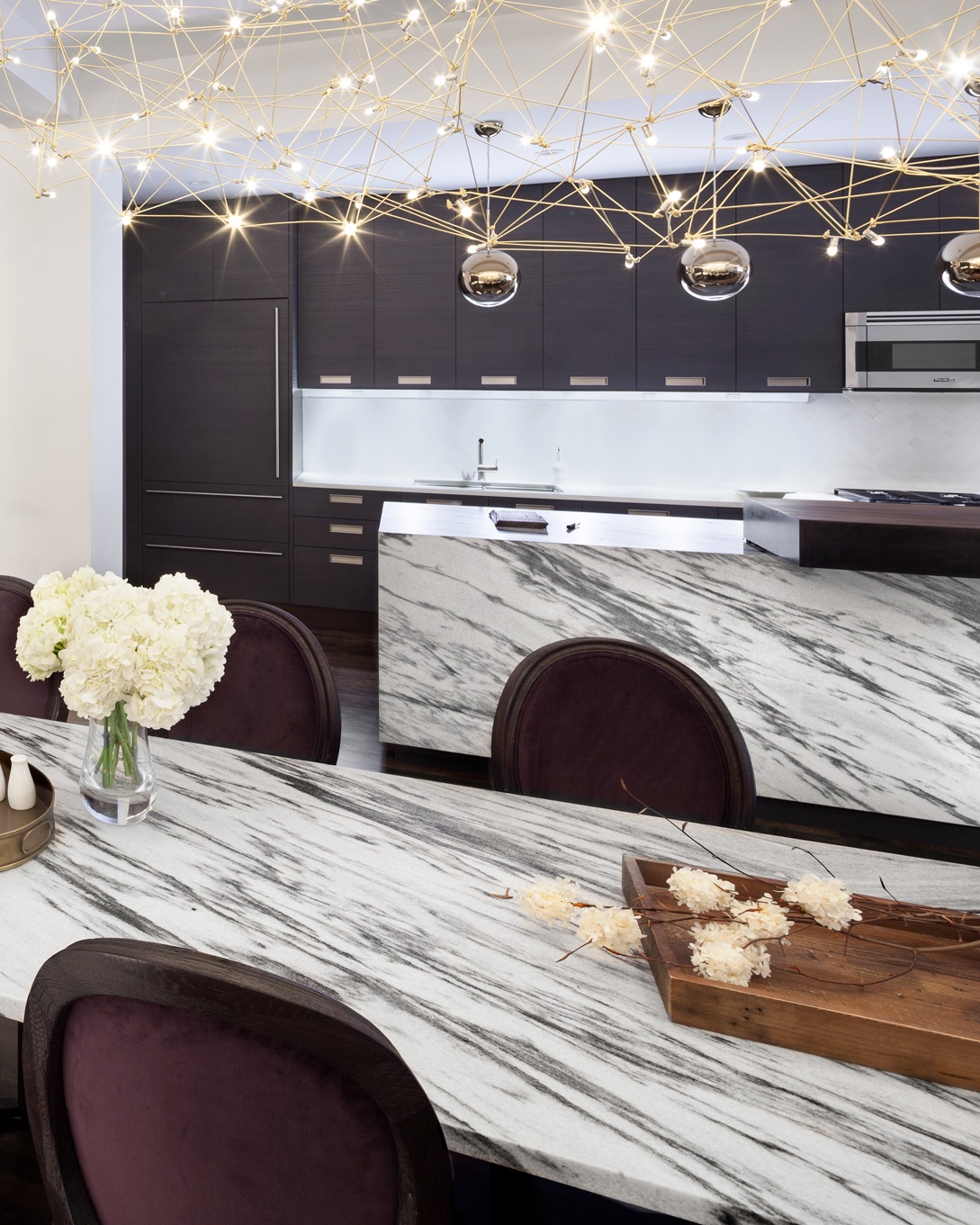How To Create a Monolithic Marble Island
In New York’s Flatiron district there is an apartment where marble floats, wood anchors and light hovers.
In the loft style home of a tech entrepreneur every surface packs visual texture with natural and man made patterns in collision on cabinets, partitions, walls and counters. And at the centerpiece of the apartment is an optical illusion – a solid block of American marble sliced down to ⅜ of an inch, backed with a composite fiber, bookmatched and reassembled into a cube.
The result is at once both visually weighty and weightless.
Recently we chatted with Young Byun of Parc Office whose team headed the design of the renovated space to find out why he used ultra thin 1 cm American marble in his design and we learned that the thin material helped him achieve both monolithic and thin sliced effects within the same space.
Parc Office is an experience design company whose projects span the worlds of culture, branding and technology. The Parc team works with clients like Google, Gucci, Adidas, and Starwood in architecture, interaction design and creative strategy in order to produce spaces that blend the built and digital realms.
Let’s hear from Byun on the project:
The owner is a tech entrepreneur that recently moved his company to New York and wanted an apartment in the city where he could live, entertain potential investors, and throw dinner parties with co-workers. It was important for our client to have as much open space as possible, and highlight the custom designed pieces (e.g. media cube, dining table, kitchen island, bar) devoid of knick knacks.

The island which measures more than 12 feet long is both visually weighty and appears to be floating. We wanted the island to showcase the juxtaposition of the light/monolithic marble block contrasting the dark/warm quality of the steel and wood top. (If the island were a solid block of marble it would weigh some 18 tons. Try getting that up the stairs…)
Pearl grey marble is quarried in Tate, GA and is know for its strength, sparkling crystalline structure and dynamic veins which are available in medium to dark grey, depending on where in the quarry the marble is sourced.

This apartment, and particularly the kitchen and dining space, incorporates a unique mixing of materials. So very different and yet they work so well together. The monolithic structure is skewered by a wood bar top undergirded with steel.
We chose a neutral palette for all the walls and ceilings to draw attention to the materiality of the marble, concrete, and wood. During a party, the island is used as a buffet station where refreshments are served while people circulate around the dining table. On the wood bar top we used torched walnut veneer wood floor paneling from LV wood .

The kitchen, and the quartz perimeter counters, were a previous installation. Our kitchen Island was designed around this.

The kitchen table, also made of 1 cm Pearl Grey marble, was built custom for the project. We had our in-house industrial designer create the designs. We wanted to span the marble as long as possible to accommodate large dinner parties. Kim Klein our furniture subcontractor fabricated the table’s steel leg base.
We chose the ultra thin marble for the table surface because we were interested in the thin yet structural qualities of the material. We wanted to span 16 feet for the dining table, and the thin material helped us achieve the floating effect of the marble. -Young Byun
We’re getting used to seeing waterfall ends on islands pretty often now, but this design takes the concept a step further. Instead of isolating only the two wrap down ends on the island in the standard waterfall style Young decided to wrap the faces all around for a completely different effect. The top is mitered to the face pieces and all the corners are mitered as well. A mix of bookmatched and consecutive slabs were supplied so there could be more leeway in the design. The table across from the island uses a bookmatched down the center for an intentional statment while increasing the length of the table itself. At 16′ x 4′ the table would have weighed nearly 1,000 lbs with 3 cm slabs, but with the 1 cm ultra-thin slabs it was only 320 lbs making it much easier to support when designing the welded base.
Parc’s design is a visually striking representation of natural materials in a sharp man-made form. The juxtaposition of the marble’s strong veining against the monochromatic cabinets givethe table and island a living quality. Expert fabrication, paired with the thin slab materialmake this monolithic marble island a fresh take on theworld’s oldest building material in it’s newest, thinnest form.




